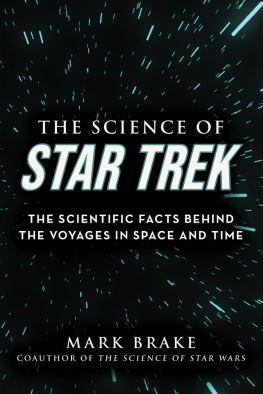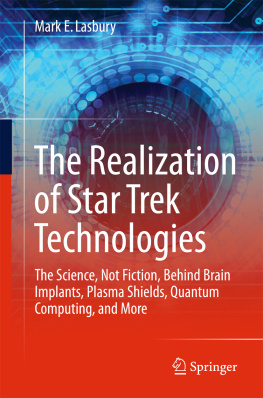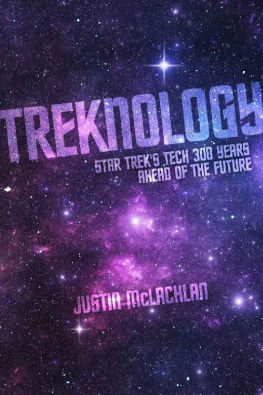STAR TREK
TREKNOLOGY
THE SCIENCE OF STAR TREK FROM TRICORDERS TO WARP DRIVE
ETHAN SIEGEL, PhD

INTRODUCTION:
THE FINAL FRONTIER
When you were young, what did you dream of when you looked to the future? Did it have anything to do with the exploration of the unknown? Of pushing back the frontiers and limits of our knowledge? Of discovering new worlds, new forms of life, or even entirely new civilizations? In some ways, the most curious of our human instincts is the pioneering spirit: to go where no one has gone before. Immediately following the launch of Sputnik 1 in October of 1957, the United States scrambled to put a satellite into orbit; in January of 1958, Explorer 1 was launched. Another two months after that, the White House made public a report from the Presidents Science Advisory Committee that contained the following sentiment:
The first of these factors is the compelling urge of man to explore and to discover, the thrust of curiosity that leads men to try to go where no one has gone before. Most of the surface of the earth has now been explored and men now turn on the exploration of outer space as their next objective.
Over the next few years, NASA was formed, the Mercury and Gemini programs propelled the United States into the lead in the Space Race, and the Apollo program promised to take humanity to the moon. Our eyes were turned skyward as never before: with hope for the real, tangible possibility that we might become a spacefaring civilization.
Space was a natural place to put our dreamsas well as our fearsabout the future. Alien invasion stories dominated science fiction in the twentieth century. Lost in Space focused on the consequences of human traits like laziness, selfishness, and nationalism during the Cold War. But when the original Star Trek series first aired, it presented a far different view of the future than any that had come before. Rather than humanity fighting an evil alien presence or continuing our own petty, earthly squabbles in a different setting, we had become a peaceful race. We had joined together in an alliance for exploration, knowledge sharing, and mutual assistance with the races of other worlds in a United Federation of Planets. And instead of highlighting the apocalyptic fears many of us had of new technologies, particularly with the threat of nuclear war hanging over the worlds head, Star Trek brought us a universe in which advanced technologies were used to bring unequivocal good to the galaxy.
The futuristic dream of what an increased investment and valuing of science and technology might bring to the world is one that has not only remained with us, but been borne out by the past five decades. Computers, barely powerful enough to calculate astronomical trajectories and so large that one took up an entire room at the inception of Star Trek, were envisioned to carry on natural-language conversations, accept and execute verbal commands, and communicate and network with other vessels and starbases, even light-years away. Handheld devices, ranging from phasers to communicators to electronic clipboards, envisioned a rise in widespread technology that we now carry around as ubiquitously as our keys. Medical devices could scan, diagnose, and even treat the sick or injured without ever touching their skin, portending many of the advances we see today. And civilian technologies like replicators and sliding doors have sprung to life with novel developments like 3D printing in ways that would seem like magic to someone dropped from the 1960s into the present day.
The AS-201 was the first test flight of the Apollo Command/Service Module and the Saturn IB launch vehicle, launched February 26, 1966, mere months before Star Treks September 8 premiere.
Star Trek wasnt afraid to dream big, either. Technologies that seemed to defy physicswarp drives that propelled starships faster than light, transporters that would dematerialize you and rematerialize you in a different location, cloaking devices that could render even a starship completely invisiblewere ubiquitous in Star Treks vision of what the future would hold for us centuries from now. When Star Trek: The Next Generation began airing in the 1980s, the envisioned future had grown even more advanced than it had been in the original series, with more ambitious and more sleekly designed technologies making their appearance. Remarkably, weve made tremendous progress toward a great many of these. Much of what once seemed to be completely impossible is now inching closer to reality, with everything from artificial eyes to holograms to androids coming into use across the world.
But part of the reason Star Trek has had such a lasting cultural impact is not just the futuristic technologies envisioned by the show, but the ethical and moral questions it brought up as well. Those questions are no less omnipresent in our world today, and are often intimately tied to the technologies themselves. As artificial intelligence efforts continue to improve at exponential rates, at what point do we begin granting rights to machines? As information becomes freer and more widespread, what does that mean for our rights to privacy, or for our mistakes to be forgiven and forgotten? If we can alter our unborn childrens genetic makeupor even our own, retroactivelywhat are the bioethical implications of doing so? If we can perform medical procedures or install implants to restore or enhance patients biological functions, should we always do so, even if there are security risks to someones own body being hacked? And if you could successfully beam an individual from one location to another, how certain can you be that the transported human who arrives at the destination is actually the same person that you transported, and not an identical copy who replaces the now-deceased original?
More than fifty years after Star Treks inception, its legacy continues to capture our collective imaginations. Our desire to push the boundaries of what were capable of knowing, inventing, and accomplishing is placed front and center in Star Trek, right alongside the importance of remaining true to the very things that make us human. Many of the dream technologies envisioned decades ago have already come to fruition; many others are well on their way to becoming reality. As we look at the real-life science and technology behind the greatest advances anticipated by Star Trek, its worth remembering that the greatest legacy of the show is its message of hope. The future can be brighter and better than our past or present has ever been. Its our continuing mission to make it so.
No matter where in the galaxy we are, even on a voyage that takes us a long way from home, a combination of advanced technology and our spirit of inventiveness and ingenuity gives us every reason to hope that we can accomplish even the most seemingly impossible goals.
STARSHIP TECHNOLOGY
















